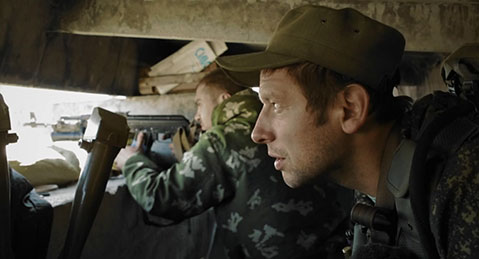Breaking Point
Filmmakers Mark Jonathan Harris & Paul Wolonsky

Foreign empires, beginning with Genghis Khan, have been invading the Ukraine for centuries, drawn by fertile soil and oceans of wheat. Three years ago, Russian strongman Vladimir Putin did the same in response to the the Maidan Uprising, the Ukrainian equivalent of Tiananmen Square. What started off as a peaceful protest against a corrupt government that did Putin’s bidding turned violent when Putin dispatched troops to restore order.
Breaking Point, made by Mark Jonathan Harris and Paul Wolonsky, provides a passionate and chilling look at how that uprising evolved with striking emotional insight into the psychology of mass movements. For a host of reasons, these events failed to seize the political imagination of mainstream America. In light of Donald Trump’s relationship with Putin, it’s clear we should have been paying closer attention.
The footage of battle scenes and police attacks is really chilling. Were you there?
Almost all the film was shot in Ukraine. The remarkable footage is from multiple camera persons, including some of the soldiers who went to war, several of them with GoPros on their helmets, in order to bear witness to the fierce battles they were fighting. Neither Paul nor I were there for these events, but we watched hundreds of hours of the raw footage in order to edit the film.
Given Trump‘s close relationship with Putin, this film will resonate more now. How would you compare Trump’s approach to the media to Putin’s?
We finished the film in the summer of 2016 when it was just becoming clear that Donald Trump was a serious candidate for the presidency. One of his chief advisors was Paul Manafort, who had worked for the corrupt President of Ukraine, Viktor Yanukovych, who was forced to flee the country after ordering his militia to turn their guns on the protestors, murdering 123 of them.
It quickly became apparent that not only does Trump have a close relationship with Putin but he has little knowledge about the annexation of Crimea, Russia’s invasion of Ukraine, or prior U.S. commitments to the country. What is also clear now from Trump’s election campaign and his transition to the presidency is that one of the common strategies he shares with Putin is his use of disinformation and lies to deflect and confuse his opposition. He could be following the Russian playbook in his use of Twitter.
Somehow the Russian invasion of Ukraine never became as big a deal as it could have here. Why do you think that is?
One reason is that Putin and the Russians are experts in disinformation and propaganda. By having Russian Special Forces take over Crimea, but do so in uniforms without insignia, Putin could claim they were not Russian soldiers. And there were enough people in the west that wanted to believe it that it muddied the waters and prevented a strong response from the West. When Russian forces went into Eastern Ukraine, they had just enough locals collaborating with them some people could argue that it was a fight between different groups of Ukrainian citizens, rather than what an overwhelmingly Russian invasion, led by Russian officers, carried out by Russian soldiers.
What did people in Ukraine think about that?
Many Ukrainians feel very betrayed and disillusioned about the West. In 1994, Ukraine had voluntarily given up its arsenal of 200 nuclear weapons in return for recognition of its sovereignty, its borders, and “security guarantees” from the U.S., the U.K., Russia, France, and China, only to discover 20 years later that the West would give very little tangible support (e.g., refusing to send Ukraine defensive weapons such as anti-tank missiles) when Ukraine needed help.
Your film was clearly very sympathetic to the Ukrainian independence movement. How unified were the Ukrainians themselves in terms of waging military resistance?
Putin’s invasion has strongly unified Ukraine. According to the Pew Research Center, some 86 percent of Ukrainians want Ukraine to remain a unitary state. The majority of volunteer soldiers who took up arms to fight the Russian invasion were Ukrainians from Eastern Ukraine whose first language is Russian. Whether primarily Ukrainian-speaking or Russian-speaking, Ukrainians from the entire country volunteered to fight and support their volunteer soldiers.
What’s the status of Ukrainian independence now?
Ukrainian independence is under siege. Russia destabilizes the political situation in Ukraine by periodically escalating the trench warfare in the East, which kills Ukrainian soldiers every day. Russia also uses its economic power to sabotage the Ukrainian economy. Ukrainians were stunned by the result of the U.S. election. They fear that Donald Trump’s bizarre admiration for Putin will cause the US to once again “sell out” Ukraine to Russia.



